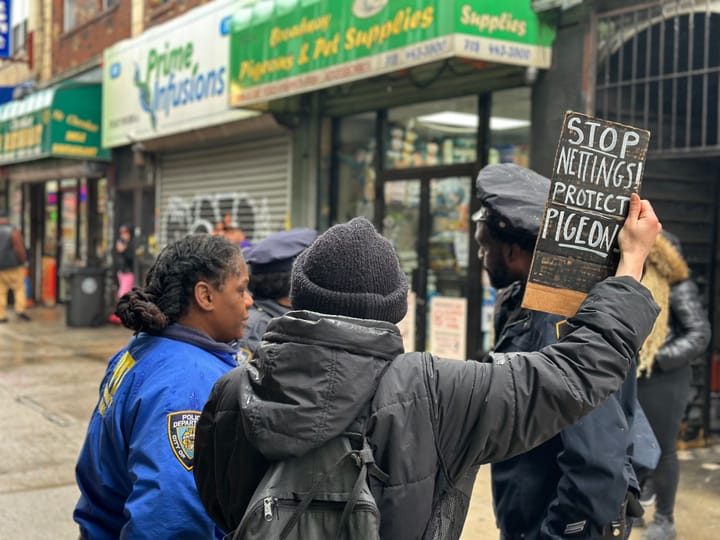Can pigeons give you bird flu? In defense of ‘rats with wings’
Trying to solve the bird flu question reveals a secret history of pigeon slander

Just like many things from 2020, bird flu’s back, baby!
Though avian influenza has been around for over 30 years, the more recent outbreak has killed 90 million domestic birds since 2020, including six million chickens in 2023. That’s a big part of why you paid $7 for eggs last year: this is the longest and deadliest outbreak of H5N1.
The strain of bird flu has spread to ducks, seals, dolphins, cows and, just last month, a cattle worker in Texas. The first mammal-to-human transmission is concerning, and had my friend asking out loud in a bar last week, “can I get bird flu from a pigeon?!” Should we be worried about a pigeon pandemic?
Pigeons, just like rats, get a bad rap. Their reputations as vectors for disease and filth dates back to the 1960s in New York City, when they were unfairly blamed for an outbreak of meningitis. Parks Commissioner Thomas Hoving referred to pigeons in June 1966 as “rats with wings” and the birds’ character never recovered, especially after it was popularized in Woody Allen’s Stardust Memories (another reason to hate Woody Allen).
So before anyone contributes to this unfair reputation, here’s the dirt on bird flu.
Do pigeons get us sick at all?
Rats without wings definitely pose a threat to humans: just last year, New York reported the highest incidences of leptospirosis (a bacterial infection spread by rat urine) since we started keeping track.
But unlike rats, pigeons don’t really pose a risk to humans in the same ways: They eat our trash but don’t go looking for it, they don’t try to live in our houses and they generally tend to build nests on ledges less accessible to humans (which is why you rarely ever see a baby pigeon).
They do, however, carry more diseases than rats. Rats can spread about 35 diseases to humans; pigeons can spread almost twice that, with 60 different diseases. Flaco, the famous owl, was killed by severe pigeon herpesvirus from eating feral pigeons (among other things). The fleas and mites that live on pigeons can spread disease, so can fluids from their eyes and beaks. But what’s most threatening is pigeon droppings.
Pigeons poop around 30 times a day and drop over 25 pounds of excrement per pigeon, per year. New York has about four million pigeons — one pigeon per two people. That’s also 100 million pounds of poop, or 4,000 garbage trucks worth.
That poop evaporates, leading to dust through which pathogens can spread when inhaled. Over 60 different diseases can spread through pigeon droppings.
Research suggests almost half of all pigeons carry a disease called, unpleasantly, Chlamydia psittaci that technically can spread to humans, but you’d have to work pretty hard to get it. Pigeon diseases typically affect people with compromised immune systems or people who inhale a lot of pigeon poop dust.
So: is bird flu one of those?
Are these boids giving me bird flu or what?
When it comes to avian influenza, researchers have been looking into it since the 1970s. Chickens and ducks can get bird flu pretty easily; but pigeons can’t.
That’s because research suggests that pigeons are unusually and highly resistant to avian influenza, and those that somehow get it don’t get very sick or spread it. Researchers have even squirted bird flu into pigeons' mouths in laboratories and they still didn’t catch it.
“These birds received 100 to 1,000 times the concentration that wild birds would encounter in nature. "We couldn't infect the pigeons,” said David Swayne, one of the study's researchers "So that's good news.”
So unless you’re ripping lines of dried pigeon poop or acting like this man with a bucket on his head trying to steal 40 of them, you’re very unlikely to get bird flu, or other illnesses, from pigeons.
Research suggests that pigeons are unusually and highly resistant to avian influenza, and those that somehow get it don’t get very sick or spread it.
So, why the 'rats with wings' nickname?
They’re viewed as dirty vehicles for disease now, but pigeons were revered and respected until just about the last century.
Many ancient cultures saw them as symbols of love, fertility and peace. They’re the bird we have the longest relationship with: they were domesticated about 7,000 years ago, for food and fertilizer. They’ve stuck with us for centuries and evolved to be messengers, war heroes and status symbols.
During the French Revolution, when peasants stormed the houses of nobility demanding their best wine and cheese, they also demanded the heads of the lords’ prized pigeons.
What changed?
Classism, for one. Pigeons became a hobby of the upper class around the 1800s. Victorians took a special interest in “pigeon fancying,” an exclusive hobby of pigeon shows and competitions. They created invitation-only clubs to keep out the lower class through high membership fees and status requirements. Though now they are on any old park bench, you used to not be able to hang out with pigeons unless you were someone.
However, pigeons are easy to tame and breed, so by the 1900s, the working class took up pigeon fancying too. Pigeon keeping used to be a popular hobby in New York, with coops on rooftops all over the Lower East Side and Brooklyn (including famously Mike Tyson’s rooftop coop), and some last stragglers in south Brooklyn. As pigeon keeping became popular with the working class, it fell out of favor with the bourgeoisie.
This pigeon nest has been in my building for at least 20 years! I have watched generations fall in love and make little pigeons for my entire adult life.
— Alex Brook Lynn (@AlexBrookLynn) October 5, 2020
This is who NYC really belongs to. pic.twitter.com/zOmbOYeEGg
Pigeons became obsolete for human needs too. People took advantage of the birds for fertilizer, food, messages and entertainment because we didn’t have much better available to us. As technology advanced, we needed the pigeons less and less.
And the final nail in the nest, pigeons became associated with disease. When Hoving, the Parks commissioner, laid the meningitis outbreak at pigeons’ claws in the ’60s, no one was fancying pigeons any more, even after they were cleared of wrongdoing.
A researcher discovered that almost every article written about pigeons after 1990 used the phrase “rats with wings." The name stuck, and so did an (inaccurate) reputation. The pigeon, the researcher said, had transformed from a minor annoyance “to a symbol of what we find vile and morally repugnant in the urban cityscape.”
So while you’re not likely to catch bird flu from pigeons, you should keep an eye on them. I mean literally, you should birdwatch pigeons, as suggested by Rosemary Mosco, author of A Pocket Guide to Pigeon Watching. They’re our neighbors, friends, and, though are now considered pests, were once considered pets, and so much more.
• Revisit Duke Reilly's "Fly By Night" exhibit from 2016, in which a massive flock of pigeons performed choreography over the East River.
• Check out the Pigeon Breed Gallery at The American Pigeon Museum in Oklahoma City.
• Read about the pigeon accused of spying for China that was freed after an eight-month detention.




Comments ()